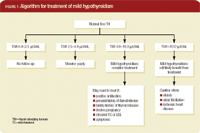When should you screen for and treat mild hypothyroidism?
Whether to treat mild hypothyroidism is controversial—but ob/gyns are increasingly concerned about links with menstrual dysfunction, infertility, early labor, and poor neurodevelopmental outcomes in offspring. In the first of two articles on subclinical thyroid disease, two experts provide the information needed to make that call.
Are you feeling increasing pressure to treat mild thyroid disease? Physicians are diagnosing such subclinical disease more and more, despite widespread disagreement and controversy about how to define and treat it. Especially in the wake of recent studies that suggest a link between both mild hypo- and hyperthyroidism and significant health risks, many of your colleagues are sensing the need to treat disease that's less than overt. In Part I, we'll focus on when you should treat mild hypothyroidism.
Coined more than 30 years ago, the term "subclinical thyroid disease" seems to have outlived its usefulness.1 Especially as we've better defined the clinical signs and complications of mild disease, the word subclinical has met with recurrent objections and has been replaced with "mild." In stark contrast, when it comes to overt clinical disease, there's no argument about treatment or diagnosis.
In fact, mild thyroid disease is very common but still complicated by controversies over the reference values of thyroid function tests upon which we base both our diagnosis of disease and many clinical decisions. With that in mind, our goal is to not only outline treatment options and guidelines, but to discuss the definitions, causes, and factors that affect your decision to treat mild hypothyroidism.
An assay to determine thyroid-stimulating hormone (TSH) is considered the most sensitive single test for measuring thyroid status. The pituitary gland secretes TSH, where it is under the negative control of triiodothyronine (T3) derived from the circulation, or from intracellular deiodination of thyroxine (T4). TSH binds to its receptor (TSHR) on the surface of thyroid follicular cells, where it regulates the formation of and release of thyroid hormone. When there is thyroid deficiency, the serum TSH level rises; conversely, when the thyroid is overactive, the TSH level falls. Hence, when the TSH level is abnormal, serum thyroid hormone levels may provide additional information about the degree of thyroid abnormality. Keep in mind that there's considerable uncertainty about the upper limit of TSH for a normal person, while the lower limit of normal is far less controversial. That's because there are several risk factors that can confound TSH reference ranges in the general population:
Defining mild hypothyroidism and its causes
As reported by most commercial assays, the upper "normal" limit for serum TSH is a level of ~5.0 μU/mL. These reference ranges, however, were based on control populations that included people with either occult thyroid disease or significant risk factors for thyroid disease, as stated above. Interestingly, when individuals with these risk factors were excluded from a large control group, the average TSH was ~1.5 μU/mL, with a range up to ~4.12 μU/mL.2 Furthermore, in one study, 95% of rigorously screened normal euthyroid volunteers had TSH values below 2.5 μU/mL.3

